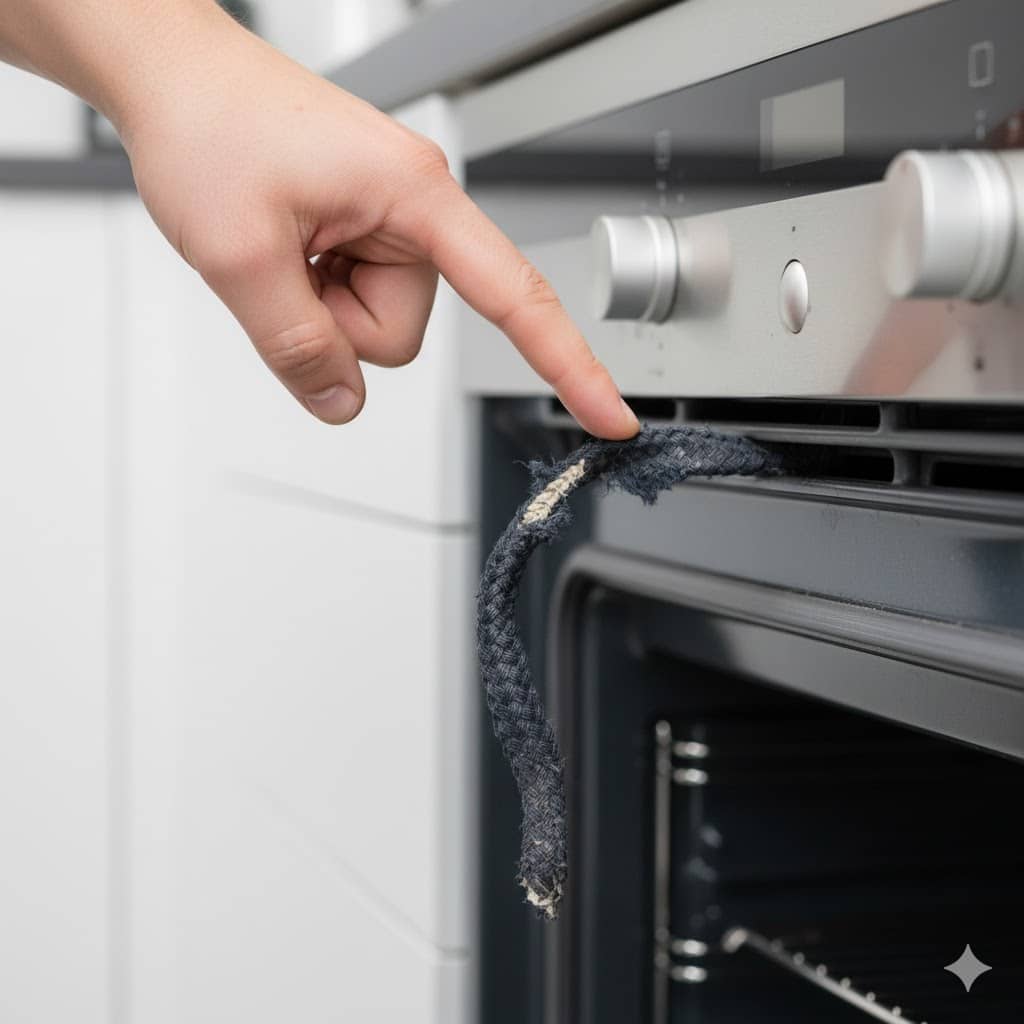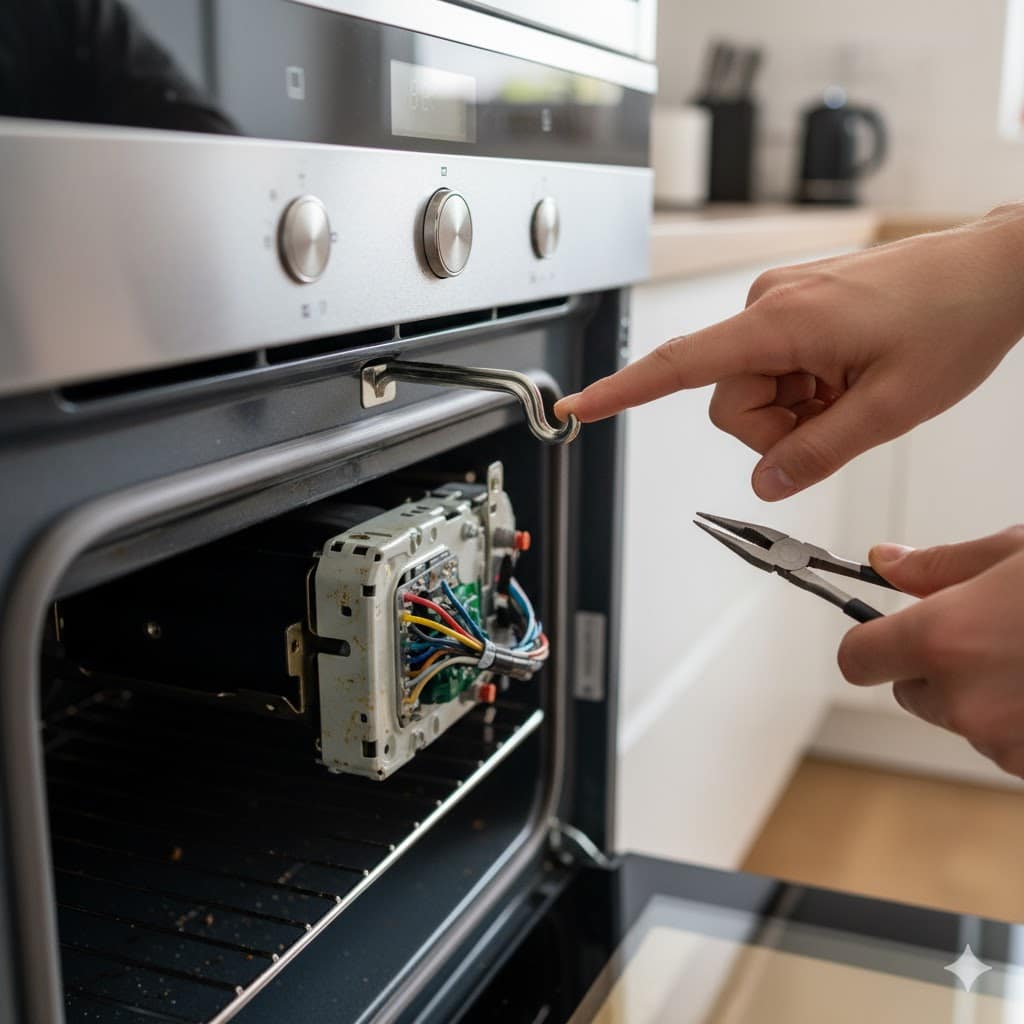Why Your Oven Door Won’t Close (And How to Fix It)
Part 1: The Problem & Why It Matters: Stop Wasting Heat
Is your roast taking forever? Is the kitchen hotter than it should be? A secure oven door is absolutely crucial for efficient cooking.
When your oven door hangs crooked, has a noticeable gap, or simply fails to seal correctly, it’s not just a minor annoyance—it compromises your appliance’s performance and wastes energy. This seemingly small fault can lead to big problems, making your oven inefficient, unreliable, and even dangerous.
The Consequences of a Gaping Door
Understanding the impact of a door that won’t close properly shows why this repair is so important:
- High Energy Bills: The moment that door seal breaks or a hinge sags, hot air immediately begins to escape. Your oven must then constantly draw more power to compensate for the continuous heat loss, meaning it runs longer and harder than necessary. This translates directly into higher monthly energy bills and unnecessary wear on your appliance’s heating elements.
- Inconsistent Food: A gaping door introduces cold air and creates extreme temperature inconsistencies inside the cavity. This results in uneven browning, undercooked centers, and recipes that suddenly take 30 to 60 minutes longer than they should. If your baking results have been unpredictable lately, your door seal might be the culprit.
- Safety Risk: When hot air is allowed to vent directly into your kitchen, the oven exterior—especially the control panel, handle, and the surrounding cabinetry—can reach dangerously high temperatures. A properly sealing door directs heat safely and keeps external surfaces cooler. A door gap is a serious burn hazard, especially if you have children or pets nearby.
Part 2: Essential Diagnosis: 4 Common Causes of a Gaping Door
Before diving into repairs, ensure the oven is completely cool and unplugged (if practical). Diagnosing the correct issue saves you time and ensures you order the right part.
-
-
Physical Obstruction (The Easiest Fix)
-

An image showing a hand pointing to an oven rack that’s slightly out of place, preventing the door from closing fully
| Area | Symptoms | Action |
| Oven Cavity & Frame | The door stops abruptly, often with a clink sound, or seems to catch on something when closing. | Inspect the oven cavity and the bottom door frame. Look for misplaced oven racks (pushed too far forward) or large pieces of dropped food/crumbs stuck near the bottom hinge area. Remove or adjust any obstruction. |
-
-
Faulty Door Seal (Gasket)
-

An image of a close-up on an oven door gasket that is clearly worn, torn, or hanging loose.
| Area | Symptoms | Action |
| Door Perimeter | You can feel hot air escaping around the edges of the door during cooking. The seal itself is brittle, torn, hanging loose, or has flattened out due to age and heat. | If the seal is loose, try gently pressing it back into the channel or onto the retaining clips. If it’s damaged, it needs to be replaced. |
-
-
Damaged or “Unsprung” Hinges
-

An image of an oven door that is visibly sagging or crooked, highlighting the hinge area.
| Area | Symptoms | Cause |
| Hinge Mechanism | The door visibly sags or hangs crooked when opened or closed, or it doesn’t “snap” shut in the final few inches, instead just lightly resting on the frame. | This is the most common mechanical failure, often caused by leaning or putting excessive weight on the door when it is fully open, which bends the hinge arms or weakens the internal springs. |
-
-
Stuck Lock Assembly (Common on Self-Cleaning Models)
-

An image showing a close-up of an oven door’s internal lock mechanism, possibly with a latch visibly extended.
| Area | Symptoms | Cause |
| Top Latch | The door stops short of fully closing because a metal hook or latch at the top or side is visibly engaged or sticking out. | This usually occurs after a self-cleaning cycle is interrupted or fails to fully retract the safety lock mechanism, preventing the door from fully seating. |
Part 3: 🔨 Ready to Fix It? Step-by-Step Solutions
A. Fixing Hinge Issues (The DIY Lifesaver)
The hinges are the structural backbone of your door. Often, they just need a little reset, but sometimes they require replacement.
- The Hinge “Reset” Trick (For minor sagging):
-
- What you need: Two clean, folded washcloths or rags.
Shows the DIY rag trick to reset the hinges.
- What you need: Two clean, folded washcloths or rags.
- Step 1: Turn off the power and place one folded rag over each of the lower hinges where they meet the oven frame. The rag should prevent the door from closing fully.
Step 2: Gently push the door closed against the compressed rags (it won’t close all the way). Use a controlled, progressive force to push against the hinges a few times.- Step 3: Remove the rags and test the door. This method often helps reset the internal tension springs.
- Hinge Replacement (For visibly bent hinges):
- Requirement: You must first purchase a new pair of hinges specific to your oven’s make and model.
- Procedure: This repair involves releasing the hinge locking clip, removing the old door (which can be heavy!), sliding the new hinges into the slots, and carefully reinstalling the door. Always replace hinges in pairs to ensure even tension.
B. Addressing a Stuck Door Lock

Shows access to the internal lock mechanism.
If the diagnosis shows the issue is a stuck door lock (usually after a self-cleaning cycle), you may need to manually reset the motor or replace the assembly entirely.
➡️ FOR A DETAILED GUIDE: If your oven door won’t close because the lock is stuck, follow the instructions in our related article: How To Replace A Range Oven Door Lock Assembly
Part 4: When to Call The Appliance Experts
While many door issues are DIY-friendly, some problems require professional service:
- Warped Door or Frame: If the impact damage is severe and the metal door or oven frame is visibly bent, this affects the entire appliance’s structure.
- Electronic Control Board Faults: If the door lock and wire harness test well, the issue may be with the electronic control board, which is expensive and complex to replace.
- Gas Appliances: If the problem involves gas lines or is causing strange odors, always call a certified technician immediately.
Final Pro Tip:
To prevent future door issues, never stand or place heavy items on your open oven door, as this is the primary cause of hinge failure. Always use the Make and Model Number (found on a sticker inside the door frame or storage drawer) when ordering replacement parts.

